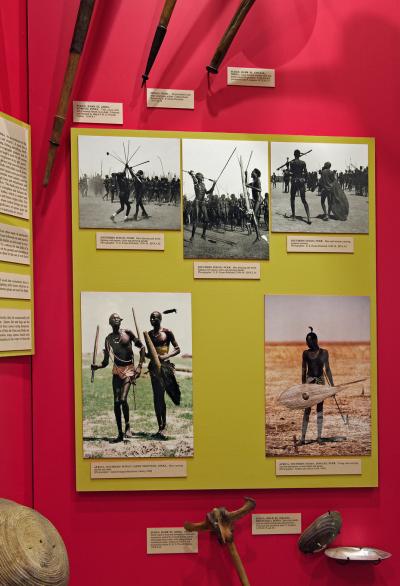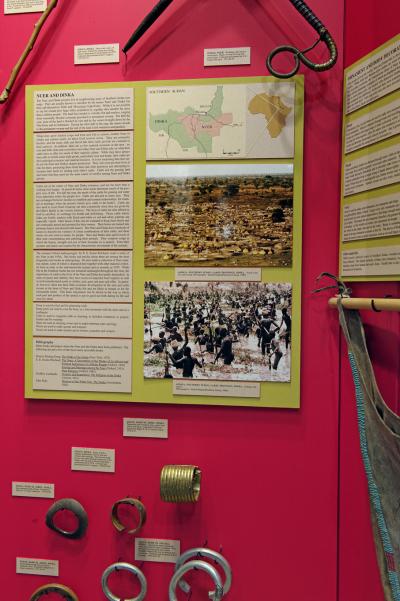Nuer and Dinka Case, Upper Gallery, Pitt Rivers Museum
This case is in the Upper Gallery of the Pitt Rivers Museum. It focuses on the cattle-herding Nuer and Dinka people of southern Sudan. It is one of the relative few cases in the museum which is culturally based, rather than typologically displays which present technological groupings of, for instance, baskets or beadwork, rather than cultural groupings. Nonetheless it sits in a broader comparative space, part of a much larger display of weapons as a comparative technology which fills much of the Upper Gallery of the Museum, the product of redisplay in the early 1990s.
Given its placing in the museum, the display focuses mainly on the spears and shields of these anthropologically-famous cattle herders from Southern Sudan, but also includes other domestic and herding objects, especially towards the bottom of the case.
Following the Pitt Rivers Museum historical style, the case carries a great density of objects. Against an eye-catching red background, the weapons are presented in the style of a nineteenth century ‘trophy’ display, which characterized both many colonial homes, and photographs of material culture from the period. The display also uses ten photographs, five black and white field photographs dating from the 1930s and five colour photographs from 1980s. They are all especially printed and mounted on card for the case, averaging about 20 cm square. They are given no informational or aesthetic prominence in the case, indeed three of them are placed low in the case and are not easily legible. Rather the photographs function within the overall informational rhetoric of the case, giving density and authority to the statements.
Although there are objects from a number of sources on the display, the case focuses on the work of the distinguished Oxford anthropologist Sir E. Evans-Pritchard. Objects collected by Evans-Pritchard, together with his ethnographic analysis form the basis for the case’s narrative, which focuses on the importance of cattle to Nuer and Dinka people. It is a case imbricated with the colonial relations which formed the infrastructure for anthropological observation. Yet this is not articulated within the case where the narrative is instead of a traditional culture that continues into the contemporary world. While the text states that “life in Southern Sudan has not remained unchanged”, the role of the photographs in this statement is complex. The emphasis is on cultural continuity but it also slips into a form of timelessness. A panel on the right of the case documents spears and shields. There are three photographs by Evans-Pritchard taken at two separate dances, but which are conflated in the narrative of the case. Below them are two colour photographs. These were taken in the mid 1980s by Sarah Errington, a distinguished photographer working in a broad documentary style, for NGOs such as Oxfam and sourced through the Hutchinson Library, and by Stephen and Alison Cobb who had worked in the region. These photographs show similar objects to those in the case still in use. Colour here is used as a signifier of the ‘present’, the ‘here and now’ to suggest continuity, as opposed to the black and white ‘past’ and ‘then’.
However the distinction is blurred because the content of the photograph and its colour have been privileged over photographic style and genre of content presentation. This has the effect of compressing time, rendering the Nuer and Dinka timeless. The photographs of Nuer men holding shield and spears, placed centrally for maximum visibility in the centre of the frame. They are reminiscent of the static images produced stylistically as photographs of ‘types’. They reference not with the contemporary peoples of Southern Sudan, but the visual rhetorics of the static trophy and the stereotypical ‘anthropological’ and ‘colonial’ photograph. The repetitious framing of the two images, male figures in front of a neutral backgraund, placed centrally in the frame, and the visual equivalence that emerges, dominate the affect of the images. With the captions which stress the material culture, the photographs move attention away from the possibility that the figure in the left hand photograph (by Sarah Errington) is moving – his foot is raised, and singing or chanting - his mouth is open. The photographic meaning carried in style has been overlooked in the focus on content.
This sense of visual continuity and temporal collapse is accentuated by two ‘over view’ photographs - of a cattle camp and of men fishing with spears. Their subject matter belies the colour of their inscription. Again the visual rhetoric of the colour photographs is identical to that of the Evans Pritchard’s black and white images. The juxtaposition of style and content in effect again compresses time within the case as continuity slips into timelessness: as the colour ‘now’ looks just like the black and white ‘then’ in style, content and presentation. The Nuer and Dinka are presented as outside both colonial time and contemporary time.
The timelessness of the case is accentuated by the fact that it represents a Southern Sudan just before the complete fracture of the war and displacement which has raged in the region for some two decades and which has only recently been resolved in the establishment, in 2011, of Southern Sudan as the world’s newest nation-state. It is, of course, always a problem with fixed museum displays, that world politics overtake their narrative. But what is significant here is the way in which the photographs both suspend time and vouch for the authority of representation, when things have long changed.
Elizabeth Edwards

